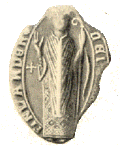Thomas (bishop of Finland)
| Thomas | |
|---|---|
| Bishop of Finland | |
| Church | Catholic |
| Diocese | Finland |
| See | presumably Nousiainen |
| In office | 1234? – 1245 |
| Predecessor | Unknown |
| Successor | Bero (Björn) |
| Personal details | |
| Born | Unknown |
| Died | 1248 Visby, Gotland |
| Christianization of Finland |
|---|
 |
| People |
| Bishops: Thomas ● Henry ● |
| Rodulff ● Fulco ● Bero |
| Popes: Alexander III ● |
| Innocent III ● Gregory IX |
| Archbishops: Anders ● |
| Valerius |
| Others: Birger Jarl ● |
| Sergius ● Lalli ● King Eric |
| Locations |
| Kokemäki ● Köyliö ● |
| Nousiainen ● Koroinen ● |
| Turku Cathedral |
| Events |
| Finnish-Novgorodian wars |
| First Swedish Crusade |
| Second Swedish Crusade |
| Third Swedish Crusade |
Thomas (Finnish: Tuomas) is the first known Bishop of Finland. Only a few facts are known about his life. He resigned in 1245 and died in Visby three years later.
The only reference to Bishop Thomas during his episcopate in Finland is a letter signed by him in Nousiainen in 1234, which granted certain lands around the parish to his chaplain Wilhelm. The lands may be related to the papal permission from Pope Gregory IX in early 1229 that authorized the church to take over all non-Christian places of worship in Finland. The letter is the oldest surviving letter written in Finland.
No further information on the bishop's activities has survived before he was granted resignation by Pope Innocent IV on 21 February 1245. According to the Pope, Thomas had admitted committing several felonies, such as torturing a man to death, and forging a papal letter. Church representatives to oversee the resignation were the Archbishop of Uppsala and the Dominican prior of the Dacian province. Thomas donated his books to the newly established Dominican convent in Sigtuna and went on to live his last years in the Dominican convent in Visby, Gotland. He died there in 1248, shortly before the Second Swedish Crusade, which cemented Swedish rule in Finland for more than 550 years.
During Thomas' episcopate, Finland is listed among the lands under the papal legate in the Baltic region, originally the Bishop of Zemgale, Baldwin, and then William of Modena, first on 28 January 1232 and last on 15 July 1244. This was a radical realignment of the bishopric's position, since the Pope had earlier used Swedish bishops to assist the Finnish church, as evident from papal letters from 1171 (or 1172), 1221 and 1229. On 24 November 1232, the Pope even asked the Livonian Brothers of the Sword to provide forces for the unnamed Bishop of Finland to defend the country against the Novgorodian attacks.
...
Wikipedia
